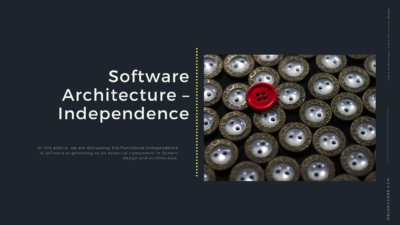This is the 7th article on the System Design and Software Architecture series. In this article, we are discussing the Core objectives and components of Design Principles is an important section in System design and architecture.
Previous articles
- Introduction to System Design and Architecture
- Values of system software
- Programming Paradigm
- Object-Oriented Programming
- Structured programming
- Functional programming
Introduction To Design Principles

Designing a plan is a ridiculous process as many broad errors have been introduced at this stage. Moreover, if these errors are not identifying until later stages, they become more difficult to correct again. Therefore a number of principles are followed in designing the software. These principles act as a framework for designers to follow good design training.
The principles of software design are the principles that are essential for software to be error-free and not for software to reach an end. Remember to upgrade or maintain new features spontaneously and continuously. Given the proper timing for the design factor in SDLC, it will not take long to change and survive with the latest changes later.
Common Design principles

Some of the design principles that are commonly followed are as follows.
- Software design must conform to the analytics model: Often a design component meets many requirements, so we need to know how the design model meets all the requirements represented by the analytics model.
- Select the correct programming parameter: Programming illustrations describe the structure of the software system. Depending on the nature and type of the application, different programming metaphors can use sometimes, such as procedure orientation, object-orientation, and prototyping parameters. The parable should need to choose to keep in mind the limitations such as time, resource availability, and user needs.
- Software design should need to uniform and integrated: Software design is considered uniform and integrated if the interfaces between the design components are properly defined. To this end, the design team established the rules, format, and design prior to designing the software.
- Software design should need to flexible: Software design should flexible enough to adapt easily to changes. To make flexibility you should apply basic design concepts such as abstraction, refinement, and modularity very effectively.
- Software design should ensure minimal conceptual (interpretation) errors: The design team should ensure that ambiguity and mismatch, which are the main conceptual errors in the design, are resolved in advance before dealing with the syntactical errors in the design model.
- Software design needs to structure to stand mild degradation: Software design should need to design to handle abnormal changes and situations, and it should be done properly if there is a need to complete it, without affecting the performance of the software.
- The software design should represent the relationship between the software and the real problem: The software design should be structured because it is always associated with the real-world problem.
- Software Reuse: Software engineers believe: ‘Do not redesign the wheel’. Therefore, software components are needed to design in such a way that they can effectively reuse effectively to increase productivity.
- Designing for test capability: A common practice followed is to keep the test phase separate from the design and implementation stages. That is, the software is first developed (designed and executed) and then handed over to testers who decide if the software is suitable for distribution and subsequent use by the customer. However, the test separation process appears to be very seriously flawed, and if any design or execution error is found after implementation, then it is very important to a complete or significant portion of the software needs to be redone. Thus, test engineers should involve from the outset. For example, they should contact analysts to set up tests to determine if they meet user needs.
- Prototyping: Prototyping should use when the requirements are not fully defined at the beginning. The user interacts with the developer to expand and refine the requirements as the development progresses. Prototyping can develop a quick ‘mockery’ of the system. This joke can use as a means to give users a sense of what the system looks like and to illustrate the functions that are included in the developed system. Prototyping also helps to reduce the risk of designing software that does not meet customer requirements.
Characteristics of design principals

Application development for small modules
Let’s first divide the application module into smaller modules and add an abstract layer on top of each layer. The developer needs to split the application into smaller modules, which makes it easier to debug and add an extra abstract layer. Then it will very easier for the other developer or someone else later. To analyze software used to improve features.
Assemble a proper need as a change
Assembling requirements is another factor in software design that changes drastically. Sometimes clients or clients need to activate a new tool or new feature to use this design factor and above the abstract layer described before use.
Moreover, it is very difficult to freeze the requirements after following the expedited methodology. Therefore, before software development can begin, the architecture for software development must be designed taking into account future implementation and development model.
Modularity as a Paradigm for Separation of Concern
Modularity is a very good model to use whenever a complex situation arises, even in everyday life situations. Any large problem will very easier to solve if it is distributed in a large and complex small piece or in a code snippet. Also, the code should not repetitive. It should need to design so that when a code change is required in the future. Also, it should not a case of using a repetitive code sniper. It should only change a code line or line and other code snippets should not that affected by that change but should solve the problem. With a small code sniper variant, the entire working procedure of a good snippet modularity system. Also, that system has the ability to easily solve in an optimal and structured way. Modularity needs to address and it must be able to use in an abstract layer.
Modularity has several major advantages:
- Testing and debugging
- Ability to reuse
- Extent
Flow notes and user representation for amplitude
Graphic representation and symbols are always a very good way of communicating and are similar to software design. Software production is divided into certain categories, such as software, to produce the desired software, so anything needed or user-centric software is required. Since architectural level designs can be created automatically without any human intervention, there is a certain procedure or method to use this software directly with other software.
Simple and Appropriate
Software design should very simple. Every class and system have written must have a common purpose. Every new upgrade should have to easy to integrate with the old software and the whole software should be easy to maintain.
Note that design principles are often limited by existing hardware configuration, implementation language, existing file and data structures, and existing organizational applications. Also, the evolution of each software design must carefully plan for future evaluations, referrals, and maintenance.
Software design principles that should need to follow as part of the software development life cycle are very good methods and practices. It helps good developers to make changes and maintain them to the maximum in the future without breaking and corrupting the software work component.
Conclusion
Thanks for reading the article Functional Programming as an essential component in System design and architecture.
My articles on medium










Pingback: ISP: The Interface Segregation Principle - Onload Code